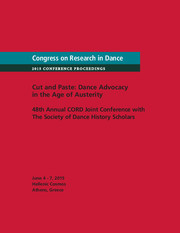Article contents
Support and Following: Re-Visiting Movement Choirs and Public Performance
Published online by Cambridge University Press: 02 August 2016
Abstract
In recent years, the theorization of dance as a critical and political practice has focused on its “resisting” qualities. “Withholding” or “arresting” are terms used to qualify dance as a means for questioning economic and artistic practices. This paper seeks to problematize such a view both by pondering the question of how to conceptualize acting bodies in forming political spaces and by grounding this discussion in a historical comparison. I will re-visit and question my previous research on movement choirs, and propose that the notion of supporting, transmitting, and sharing are strategies commensurately significant with choreographies of protest.
- Type
- Research Article
- Information
- Copyright
- Copyright © Yvonne Hardt 2016
References
Works Cited
- 2
- Cited by


